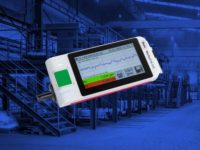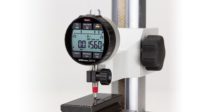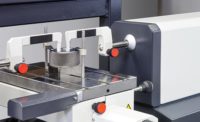Pushing the Limits of Air Gaging—And Keeping Them There
Air gaging gives you a fast measurement device that provides superior reliability in the dirtiest shop environment.














Air gaging allows you to measure many jobs faster, more conveniently, and more accurately than by using other gaging methods. In the measurement of hole conditions, air gaging is unsurpassed for speed and accuracy, while in checking any dimensional characteristic, air offers sufficient magnification and reliability to measure tolerances well beyond the scope of mechanical gages.
Air gages also effectively measure all common types of dimensions and are particularly suited to checking dimensional relationships. Some of these are taper, parallelism, squareness, straightness, and center distance. Match gaging, which permits the selection of mating parts with a specified amount of clearance or interference, is easily accomplished with just one reading on one dial.
TECH TIPSAir gages effectively measure all common types of dimensions and are particularly suited to checking dimensional relationships. Some of these are taper, parallelism, squareness, straightness, and center distance. Virtually no other gaging system can put the sensors (in this case the air jets) so close together to allow for multiple diameters or geometric conditions in very small pieces of tooling. |
One of the great things about air gaging is the fact that virtually no other gaging system can put the sensors (in this case the air jets) so close together to allow for multiple diameters or geometric conditions in very small pieces of tooling. In fact the jet itself may set the first limitation on the capability of air tooling design.
Pushing the limits - Land width
While there may be a little variation between manufacturers, most air jets are typically 0.050” in diameter. With a two-circuit air plug there would be two jets this size. To have an effective air system, the entire jet must be covered so that there is no blow-by of the jets off the surface being measured. However, it would not be possible to measure a land width of 0.050” with a 0.050” jet as the air must meet resistance around the entirety of its opening. And considering the imperfections on the corners of the land being measured, the tolerances of the land and jet—along with trying to position the jet over the surface— it’s better to set the limit of the typical land width to around .100”.
But there are ways to work on smaller land widths. One way is to use a three-jet piece of tooling. Most two- and three-jet systems work on the same air amplifier, so the actual air jet cross-flow of a two-jet system must equal the area of a three-jet system. Thus, the air jet on a three-jet plug would typically be around 0.034”, allowing you to measure lands 0.084” in width.
But wait, there’s more. There are other slit jet configurations available, or where tolerances are tight, higher magnification options. These can allow for land widths as small as 0.040”.
Pushing the limits - Jet center distance
But the fact that you can get the sensors close together to make checks for taper or squareness may also impose limits, despite the measuring capability.
Here are two examples:
With the typical taper gage, whether it’s a “jam” style that measures only taper or a clearance style that measures two diameters and taper, the two pairs of jets are set to two different heights on the taper (see Figure 1). The gage reflects a differential change between two diameters at a fixed distance along the part.
With a squareness (perpendicularity) gage, jet spacing is similar but the circuit created to combine the jets is different (see Figure 2). Top and bottom jets on each side of the air plug are channeled to opposite sides of a special air meter to provide a differential type measurement. Lack of squareness is indicated by movement of the meter hand as the part is rotated on a reference platen. This method is used primarily when the squareness reading should not be influenced by any taper condition.
The limitations of these measurements stem from jet placement. With good machining, air jets can be put very close together and it is not unusual to see jet spacing as close as .20” between the centerlines of the jets (or smaller). That is a great feature of air gage tooling. But think about how this affects part tolerances.
Let’s say that the specified tolerance for taper is +0.001”/-0.000” per foot. This 0.001”/ft. tolerance seems easy enough to achieve until you look at the complexity of the inspection process. First, most parts we see are much shorter than one foot, so most air gages actually compare diameters that are just 3” or 4” apart. This is no problem, but if you want to measure this taper tolerance over a very short distance, there can be issues.
Consider the same tolerance on a part where we have 0.20” jet spacing: this part has to meet a gaged tolerance of 0.001” ÷ 60, or 0.000016”. Most common air gaging resolves to 10 µin and even high magnification air gaging only safely resolves to 5 µin. This does not leave much room for any part, gage, environment, operator or master variation.
Second, think about the master for the gage. Masters like to be at least five to ten times better than the system they are being used on. Or think about the gages required to measure these masters: there are enough zeros in these numbers to make the national debt envious!
Beyond that, there is the concept of trying to achieve a 10% GR&R. As this is about 4% of part tolerance, or 0.64 µin, it is just plain unattainable.
Perpendicularity gaging works in a very similar way. It is often specified over an entire length of the surface being measured and is subject to the same ratio reduction as the angular reading seen in the taper check.
So how does one achieve these measurements with certainty on the shop floor? With tighter tolerances, the old 10:1 rule for gaging is out the window. Achieving 5:1 may also be a stretch. At some point, some gaging just may not be capable of these tight tolerances over such a short area. Is it gaging at this point, or just an indication of what is happening? In some cases, an indication of what is happening is all that can be expected.
Pushing the limits - Surface finish
Air gaging gives you a fast measurement device that provides superior reliability in the dirtiest shop environment. But you give up things like measurement range and a clear delineation of surface. Air gaging has about 10-20% of the range of a typical electronic transducer with similar resolution.
In addition, the response of air to surface finish is more complicated. Think again of the air jet. The measurement ‘point’ is really the average area of the surface the jet is covering. Now consider the finish, or roughness, of that surface. The measurement point of the air jet is actually the average of the peaks and valleys the jet is exposed to. This is not the same measured point you would have if a contact type probe is used. This difference is a source of gaging error, and one that is most often apparent when two different inspection processes are used.
For example, let’s say we have a surface finish of 100µ” on a part, and we’re measuring with an air gage comparator and a two-jet air plug that has a range typically used to measure a 0.003” tolerance. The typical gaging rule says you should have no sources of error greater than 10% of the tolerance. In this example, that’s 0.0003”. If we used this plug on the 100µ” surface, the average measuring line is really 50µ” below the peak line. Double this error with two jets and you get 0.0001” or 30% of the allowable error. That’s pretty significant and air would probably not be a good choice for this part. As a general rule, the limit for surface finish with an air gage is about 60µ”, but it really depends on the part tolerance.
This source of error should also be considered when setting the plug and comparator to pneumatic zero. If the master and the part have similar surface finishes, then there is little problem. Most master rings are lapped to better then a 5µ” finish. However, if the gage is now used on a 200µ” finish part, there would be significant error introduced. For most applications, there should be no more than 50µ” difference between the master and the part the gage is measuring. Even this can be significant if the tolerance of the part is as little as 0.001”.
However there may be some cases where this limit can be pushed and worked around. A case in point might be a very long bore—maybe 30 feet or more—and where you need to measure a lot of them. Pushing a contact type probe 30 feet into a bore is certainly going to cause some contact wear. Air gaging may be the option with the right bit of consideration. If the surface finish is high but consistent, then basically a “Master Deviation” can be used to correct for the difference between mastering on a master ring surface and the part surface. With a little bit of calculation and experimentation, this source of error can be minimized and allow for another good air gage application.
Pushing the limits - Speed of response
For most air gaging applications the speed of response of the measuring system is not a consideration. Most air gages are hand or bench mounted applications, manually loaded and with seconds between subsequent parts. No issue here as the air gage provides readings as fast as the operator can load parts.
But what if air gaging is the measuring system for an automated process? Maybe the bores are small and air gaging is the only way to get multiple diameters at once or at different orientations? There may be a limit here to think about.
What it comes down to is the nature of the air itself. It’s typically not the mechanical display or the pneumatic transducers sensing the air pressure: these can operate to parts of a second. The issue is that air is a compressible medium and you are dealing with back pressure: the air pressure at the gages’ sensors has to build up for each measurement. In a typical air gage setup one might have a three-foot air hose between the air plug and the meter. Normally when the air plug is not in use the air is blowing to atmosphere. Then the part being measured is placed onto the plug. Back pressure starts to build as the restriction to the jet is created and it has to compress the air through the hose back to the display before the pressure stabilizes and the readout displays the result. The longer the hose, the longer the time to a stabilized result. This can add seconds to a typical air gage application.
But there are a couple of easy ways to get around this. The first is to shorten the hose and place the pneumatic-to-electronic sensor as close to the tooling as possible. Since the air itself is the biggest influence, reducing the amount of air in the measuring loop is one of the easiest ways to speed up the process.
But even stabilizing the air between the jets, through the tooling, and to the sensor can eat up valuable parts of a second when employed in an automated process. For these applications the key might be to keep the depressurization between measurements to a bare minimum. This can be done by keeping the measuring jets covered by the master, or by a precision tube, while not in the part. A typical scenario might be where a part is placed in a fixture by a robot. Once in place the air plug is automatically inserted into the bore to make the measurement. By keeping the air jets covered as much as possible, the response time can be minimized.
Looking for a reprint of this article?
From high-res PDFs to custom plaques, order your copy today!









